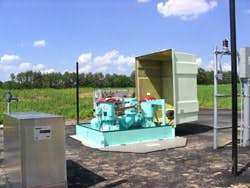Well-Mounted Pump Stations Yield Major Repair & Maintenance Savings Over Submersibles
Today’s utility managers and public officials are faced with the challenge of keeping their systems going with dwindling funds. Instituting sound asset management practices provides a framework for acquiring and analyzing data in order to make improved decisions in the future for all kinds of infrastructure, including wastewater lift stations.
In the greater Kansas City area, one particular district manages nearly 60 lift stations within a collection system of nearly 1,000 miles of sewers feeding four different wastewater treatment plants. As part of a new approach to lift station maintenance in 2002, the district began to track all expenditures on labor and materials for each lift station. From this compilation of data, the district can not only realize the total financial impact of lift station maintenance, but can also identify the impact of individual lift station cost and thereby develop a true life cycle cost profile.
One such profiling compiled all repair and maintenance costs between 2002 and 2005 of its 36 small duplex lift stations, 18 of which were Smith & Loveless Wet Well Mounted Pump Stations (WWMPS) equipped with S&L vacuum-primed pumps, and 18 were submersible pumps stations with pumps supplied by six different manufacturers. Aside from the radical difference in pump construction and location, all of the lift stations featured similar pumping conditions: peak flow capacities of 1,000 gal per minute (gpm) and total daily flows up to 50,000 gal per day (gpd). Other commonalties included central electrical controls, check valves, and plug or gate valves for each pump. The S&L WWMPS included fiberglass enclosures and station environmental equipment, while the submersible stations included pump guide rails and access hatches. The average age of the S&L WWMPS was 17 years with an average flow of 16,228 gpd. The submersible station average age was 14 years with an average flow of 19,493 gpd.
By logging all maintenance and repair data into a comprehensive spreadsheet that delineated flow measurement data, labor hours and rates, procured materials and outside contractor expenses, significant total cost of ownership conclusions were gleaned when comparing the S&L WWMPS and submersible lift stations.
Figure 1 shows the aggregate totals for each lift station type over a 36-month period. It shows that the total maintenance and repair costs of the 18 submersibles totaled $214,178, compared to the cost of only $92,380 for the 18 S&L WWMPS. The difference is a staggering $121,798 for an average of more than $40,000 per year and $2,400 per lift station per year. The compilation shows that the above-grade S&L WWMPS saved the utility 57% in total maintenance and repairs.
The cornerstone of the S&L WWMPS concept is the lowest proven cost of ownership throughout the life of the pump station. This stems from several important design attributes. Most noticeable is the above-grade location of all station equipment, including pumps, valves, and controls in a compact arrangement above the wet well. This design allows the extreme ease of quick and safe inspection, while eliminating all confined space hassles—inherent with submersible stations—or routine maintenance.
Durable, high-efficiency Smith & Loveless pumps—both in terms of motor and pumping efficiencies—draw less power than alternate pumping schemes while vertical pump construction design promotes typical service life of 25-plus years and the ease of routine maintenance.
Additionally, removing the entire rotating assembly is simplified; merely removing eight capscrews connecting the motor adapter to the volute facilitates full access to the volute and suction elbow. This gives maintenance staff the ability to perform virtually all pump maintenance and repairs onsite—if desired—without the use of outside contractors or expensive pump maintenance centers. This was reflected in the comparison in which Smith & Loveless stations required 79% less funds for outside contractors.
Smith & Loveless WWMPS are available in 2-pump, 3-pump, and 4-pump series arrangements, in completely above-grade, semi-recessed and CAPSULAR configurations. Pumping capacities for the WWMPS (with pumps up to 12 in. in size) are available up to 20,000 gpm and 500 ft TDH.
As the data from maintenance and repair tracking demonstrated, less labor time (whether internal or external) and less material costs contribute significantly to the bottom-line for utilities and municipalities with multiple lift stations. The Smith & Loveless WWMPS fosters safe and simpler preventative maintenance while providing long-term reliability.
